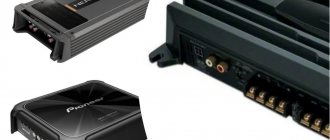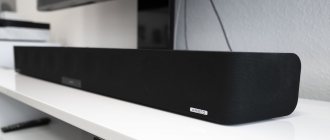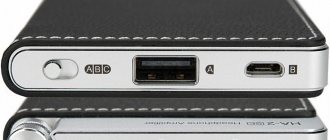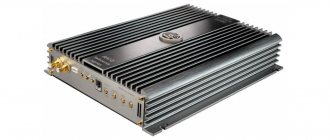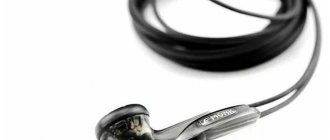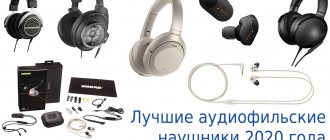Almost all gadgets - phones, tablets, players, laptops - have headphone outputs, they work and provide sound. However, it is interesting that with different amplifiers the output results in a completely different sound at the same volume on the same headphones. So what's the trick? A separate amplifier increases detail, changes the atmosphere of the sound, ensures maximum compliance with the source, and minimizes distortion.
Why do you need a headphone amplifier?
Replacing headphones may not always meet expectations for sound quality, but connecting an amplification device invariably guarantees a decent result.
The amplifier receives the audio signal from the source and amplifies its current and voltage to the required level of the headphones to obtain high-quality playback.
Hi-Res Audio
Modern smartphones are capable of supporting a similar standard, and Hi-Res is moving from a narrow segment niche into the big picture.
The sound quality is higher frequency than CD. The Hi-Res format is characterized by a sampling frequency from 96 to 192 kHz, with a frequency of 24 bits. For CD sound the parameters are 16 bits and 44.1 kHz.
The sampling rate is the number of times a signal is sampled per second in order to convert it into a “digital” signal from an analog state.
Advantages of Hi-Res Audio:
- high level of sound quality;
- Availability of sites for downloading in low bitrate compression formats.
Disadvantages of Hi-Res Audio:
- large file size, which makes transmission via Wi-Fi or mobile network difficult;
- there are restrictions on compatibility of Hi-Res audio formats.
DAC
The digital-to-analog converter is an element of the source-DAC-headphones circuit to increase sound quality. In headphones and speakers, sound reproduction is carried out using an analog signal. Audio CDs and the hard drive store files in digital format.
From which it follows that in order to obtain sound in headphones, digital-to-analog conversion must occur. The built-in DAC chip is an integral part of the amplifiers.
Balanced output
A balanced audio connection uses a balanced line connection type. The area of use was initially at concert venues and recording studios, as it provides the advantage of connecting through long cables that do not allow external interference to pass through.
With a balanced connection, a “phase-antiphase-ground” circuit is used, which allows you to “subtract” interference while maintaining the signal.
Fiio Taishan for home movie lovers
The Taishan model has optical and coaxial inputs for supplying a digital stream, as well as RCA connectors and a mini-jack socket. The device is ideal for use in conjunction with vinyl and other turntables, televisions or mini-systems to enhance the overall sound quality.
Amplifier selection criteria
Size
The dimensions of the device indicate its power, which depends on the output voltage, maximum output power and resistance.
Full-size headphones can hardly be adequately boosted by a small-sized amplification device. The ratio of the sensitivity of the headphones to the final volume level determines their output:
- from 1 to 2 V;
- 5 V.
The internal resistance of the headphones must correspond to the parameters of the amplifier, otherwise the output stage will be overloaded and distortion, both nonlinear and linear, will increase.
Amplifier classes
In total, there are three classes of amplifying devices:
- A;
- IN;
- AB.
“A” - amplification devices of the best quality and value, without distortion and maximum linearity. The negative side of the class is overheating and low efficiency. In the final stage the quiescent current is several amperes. “B” - devices operate at half-cycle, half of the wave is “quenched”, but the efficiency is more than 50%. “AB” is an intermediate class between the two above; a characteristic feature is the reduction of distortion by shifting at the beginning of the signal. The maximum value of the quiescent current is up to 150 mA.
Type
The entire numerous range of headphone amplification devices are divided into 2 types:
- stationary;
- portable - to improve the quality of playback via a phone, without purchasing a separate device - a player.
Specifications
- Frequency range: 20 Hz – 20 KHz
- Output Power: 200mW @ 32Ω
- Output impedance:
- Signal to noise ratio: >105 dB
- Channel imbalance:
- Total harmonic distortion:
- Channel Separation: >70 dB @ 1 KHz
- Voltage swing: 7.39 V
- Recommended load impedance: 16Ω – 150Ω
- Input: micro USB
- Outputs: 3.5 mm TRS headphone and line
- Power supply: USB bus, 5 V, 500 mA
- Dimensions: 79 mm x 49.1 mm x 21 mm
- Weight: 78 gr.
The bass boost function adds a little less than 6 dB, which has a beneficial effect on the overall panorama, adding warmth and volume to compositions, rather than drowning out other frequencies with boominess. In its price segment, Fiio E10K has every right to be one of the clear leaders in all characteristics.
Test track:
Led Zeppelin – Stairway to Heaven : The composition has an airy feel and a clear separation of instruments. The rhythm section is located behind the guitar and vocalist, and there is a flow of cymbals. In general, Fiio E10K plays the composition very well.
How to choose the right one
Almost all models have semiconductor circuitry, but there are also tube devices. The main task is to combine existing headphones with the purchased amplifier, or set the task of purchasing both devices at the same time. Headphones can be high-impedance - from 100 Ohms, and low-impedance, not every power can be achieved by a “weak” model. The good sensitivity of high-impedance headphones does not directly affect the volume level.
Price
Manufacturers occupy certain price niches; the following price groups can be distinguished:
- up to 10,000 rubles;
- up to 15,000 rubles;
- several tens of thousands of rubles.
It is difficult to decide which brand of device is better; the price ranges for both portable and stationary devices vary greatly.
Functional
Amplifiers with a built-in DAC have expanded functionality, this applies to:
- various sound sources;
- combination with other devices;
- the ability to adjust the level of “bass” for metal lovers and fans of hard rock;
- the presence of several inputs and outputs.
Playback quality
Sound is assessed according to the following basic parameters:
- detailing;
- stage depth and width;
- low, medium and high frequencies;
- noise level;
- purity;
- degree of proximity to the source.
Design and build quality
Famous brands try to adhere to a certain line of style and design. The desire for lightness and mobility of models remains in demand; bulky systems have sunk into oblivion.
For stationary devices, the priority is strength and reliability; for portable devices, size and thickness come first with the possibility of a “sandwich” configuration.
Volume
When comparing several amplifying devices by volume, they use voltage parameters that are measured by dBV; it is the difference in voltage numbers that indicates the volume delta in dB.
Errors in selection
The main erroneous calculations include:
- incorrectly selected device power;
- their mutual inconsistency;
- lack of necessary inputs, outputs and cords, connections in the package;
- insufficient functionality;
- weak battery:
- sound quality.
So is it a scam or a must have?
I spent a long time listening to different tracks through the various portable amplifiers presented in this review. In my opinion, the use of such devices generally improves the experience of listening to songs through mobile devices. There is certainly an increase in overall volume, depth and in some cases the instruments are revealed.
Among the variety of products presented, Fiio has portable amplifier options for anyone to listen to and judge for themselves whether the listening experience changes or not. I listen to a lot of music and I can say with confidence that using portable amplifiers makes music really sound different. At least an order of magnitude louder.
I believe that portable amplifiers are by no means a scam, but for true music lovers they are an undoubted must-have.
( 1 votes, overall rating: 5.00 out of 5)
